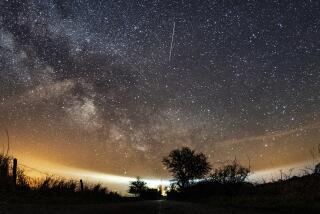Ringside Seat : Astronomers Run for Telescopes for a ‘Once in a Lifetime’ Look at Saturn
- Share via
Amateur and professional astronomers will be heading for high ground this weekend for an extraordinary look at one of the solar system’s most popular celestial bodies.
Saturn will pass directly in front of a bright star Sunday night in what is called an “occultation,” offering what the University of Arizona described as a “once-in-a-lifetime look” at the planet and its largest moon.
All astronomical eyes will be turned toward Saturn for the extraordinary event, ranging from small amateur telescopes to the largest scope in the country, the 200-inch giant atop Palomar Mountain in northern San Diego County.
The star, called 28 Sagittarii, will backlight the planet as Saturn moves across the southeastern sky. What makes the event particularly important is that 28 Sagittarii is an exceptionally bright star and Saturn will be oriented so that its rings should appear spectacular.
During some occultations in the past the planet has been oriented so that the rings were viewed from the edge, but this time Saturn will present a broadside view with the rings forming a giant doughnut around the planet. That will allow astronomers to make precise measurements of Saturn, its atmosphere and rings. By determining how long it takes the star to pass behind the planet, for example, astronomers will be able to measure Saturn’s diameter precisely.
“This event is absolutely God-given,” said Carolyn C. Porco, a research scientist at the University of Arizona’s Lunar and Planetary Laboratory. She is a prime mover in a collaboration that will send astronomers to major observatories in Arizona, Hawaii and Chile to study the occultation.
The event will give scientists a chance to see if anything has changed since the Voyager spacecraft visited Saturn eight years ago. Keith Matthews, a Caltech physicist, will use Palomar’s monster scope to study the “post-Voyager structure” of the rings to see if they have changed since the 1981 flyby.
Although scientists will witness the event from observatories across Europe and on several continents, nowhere will the viewing be any better than in the southwestern United States, said Dennis Mammana, an astronomer with the Reuben H. Fleet Space Theater in San Diego. Professional astronomers will head for various observatories, including Mt. Wilson, and amateurs will camp out by the hundreds at elevations high enough to afford a clear view.
Even a fairly small amateur telescope should offer an interesting view of the event, Mammana said. Saturn will be just to the upper left of the “teapot” of the constellation Sagittarius, and it will rise above the southeastern horizon shortly after sunset.
By 11 p.m. Sunday, Saturn will be 27 degrees above the horizon on a compass heading of 150 degrees, said Patrick So, astronomy lecturer at Griffith Observatory. It will be the brightest object in that part of the sky, and it will have a “slightly yellowish hue,” he added.
As Saturn moves westward, its rings will begin to pass in front of the star at 11 p.m. That will cause the star to dim and even blink on and off, depending on the density of the dusty rings at any moment. By around 11:50, the star should disappear entirely as it passes behind the atmosphere of Saturn, where it will remain for about an hour and a half.
One event that will be of particular interest will be the extremely rare “central flash,” which should occur when the planet is centered in front of the star. Saturn’s atmosphere will bend the starlight, causing a halo effect.
William B. Hubbard of the University of Arizona, who helped organize the network of observers, said this will be the first time that astronomers have been able to photograph a central flash at Saturn.
The show will end about 2:26 a.m. Monday when the star emerges from behind the eastern side of Saturn’s rings.






